
©
Are you tired of the dull, lifeless patch of shade in your yard? Don’t despair! There is hope for transforming those shady spots into vibrant green spaces. Get to know the top contenders in the world of types of grass that grow in shade.
These resilient varieties possess a unique ability to adapt and flourish despite limited sunlight. Here are the top seven best types of grass that grow in the shade!
1. Fine Fescue
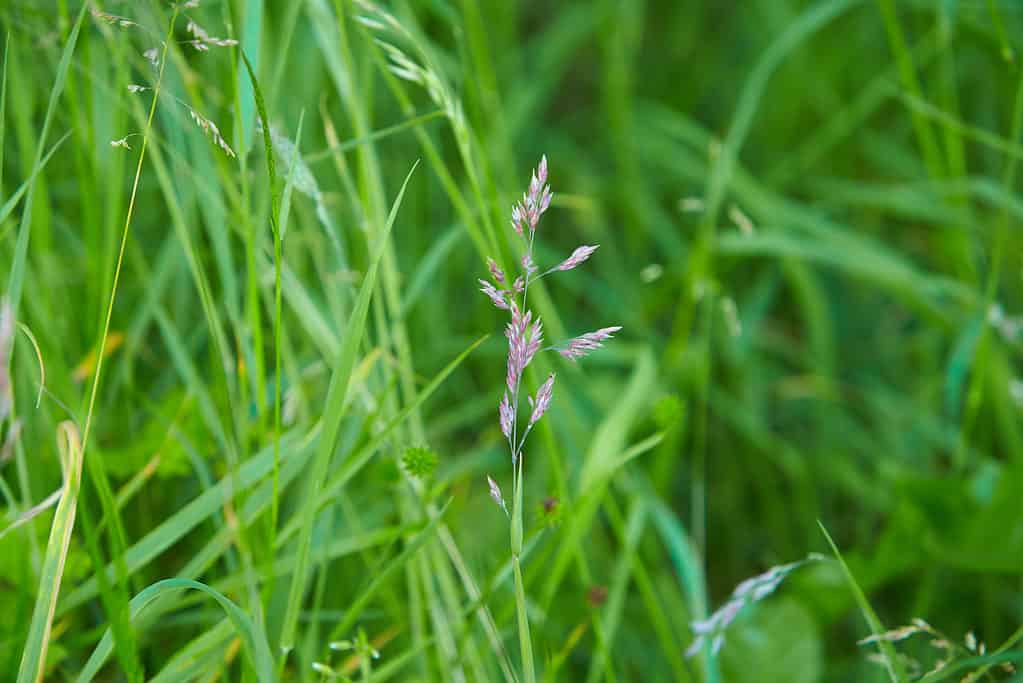
People sometimes mistake fine fescue for tall fescue, seen here.
©iStock.com/Irina Pislari
Fine fescue is an environmentally friendly choice for turf lawns. Its rapid germination and easy establishment make it a popular option, often combined with bluegrass, rye, and various types of fine fescue. Among all turfgrasses, it boasts exceptional tolerance to shade.
This grass features medium to blue-green leaves with a finely textured appearance. People sometimes mistake fine fescue for tall fescue, but it’s delicate foliage and superior performance in shaded areas serve as distinguishing features.
Thriving in challenging soil conditions like rocky, sandy, or clay landscapes, fine fescue has limited suitability for high-traffic areas. For gardens in northern regions and warm locations with shade, growers should cultivate a blend of fine fescue varieties.
Primarily used as lawn grass, fine fescue is not suitable for grazing purposes. Its ability to withstand shade makes it particularly appealing to gardeners with ample tree cover, and even in low light, the turf remains robust and dense. During periods of high summer temperatures exceeding 90°F, it may go dormant but will recover when cooler conditions prevail.
Fine fescues have recently gained recognition for their low maintenance requirements. They have a slow growth rate and, if left uncut, reach a height of only 8 to 12 inches. These grasses do not demand excessive fertilization and thrive in dry, nutrient-poor soil.
It’s fine texture and attractive color make it an appealing aesthetic choice. Finally, because it is more environmentally friendly than other turfgrass options, such as Kentucky bluegrass, it can be a good choice for those looking to reduce their environmental footprint.
2. Velvet Bentgrass
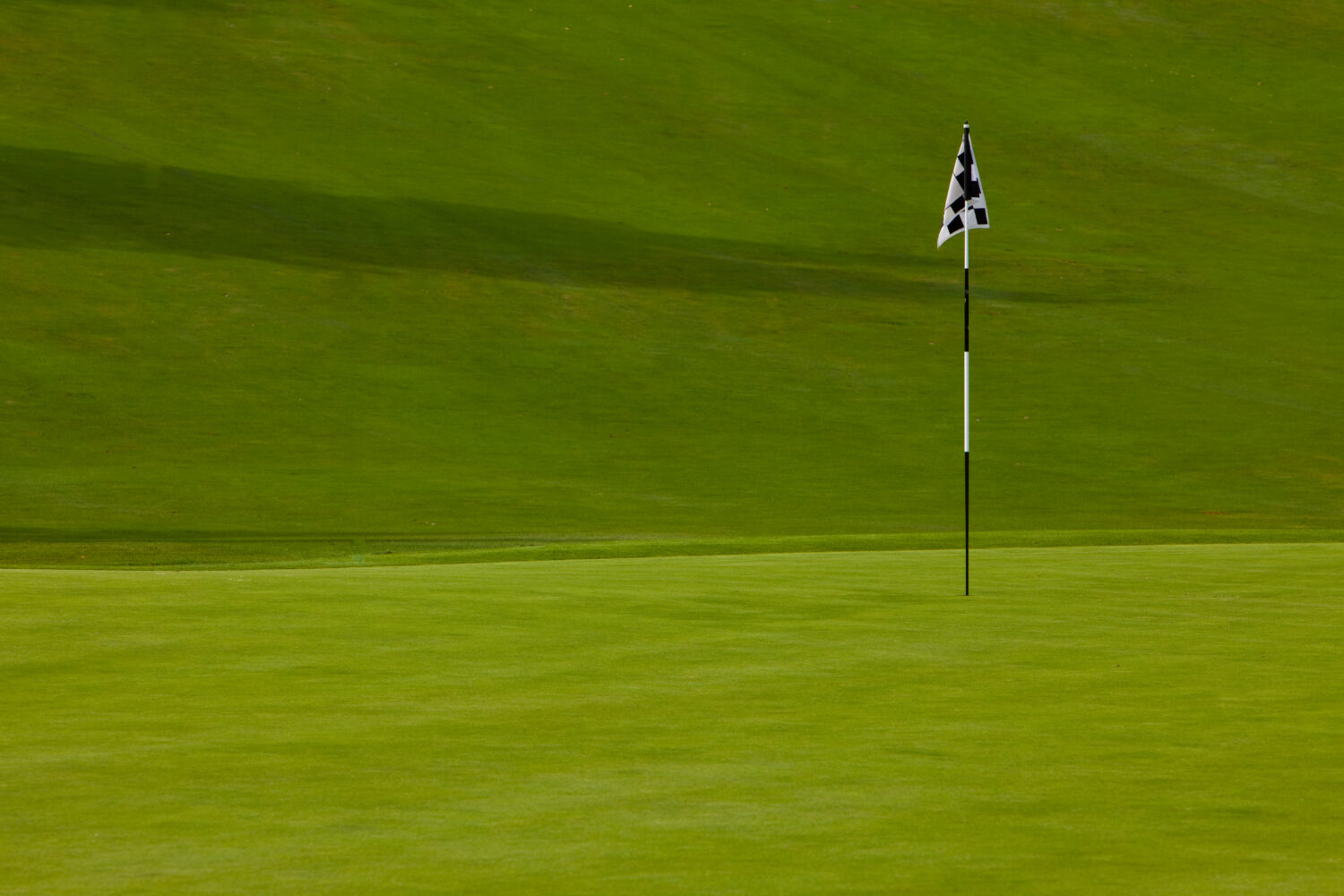
Velvet bentgrass is often used on golf course fairways, putting greens, and tees.
Image: photoinnovation, Shutterstock
©photoinnovation/Shutterstock.com
Velvet bentgrass is a cool-season grass species that is well-known for its lush and dense appearance. It is commonly utilized on golf course fairways, putting greens, and tees due to its desirable qualities.
Regarding its visual appeal, velvet bentgrass exhibits a vibrant green hue and possesses a fine, velvety texture. Its growth pattern forms a thick layer of leaves that effectively suppresses weed growth and ensures a consistent surface. However, this dense growth habit requires regular upkeep, including frequent mowing, watering, and fertilization, to maintain its optimal condition. Furthermore, the dense growth habit can also make it susceptible to thatch buildup, which can negatively impact its overall health. Regular maintenance practices, such as dethatching, can help prevent this issue. Interestingly, velvet bentgrass boasts exceptional resilience to drought, shade, and diseases, all while requiring minimal nitrogen fertilization. But while velvet bentgrass is relatively tolerant of shade, it still performs best in full sun conditions, and excessive shade can lead to thinning and reduced vigor.
One notable characteristic of velvet bentgrass is its ability to withstand low mowing heights, making it an excellent choice for golf courses seeking a close-cut turf. In addition, its dense and carpet-like surface offers golfers a smooth and uniform playing experience.
Furthermore, preliminary studies indicate that velvet bentgrass may have superior shade tolerance compared to creeping bentgrass, particularly at the fairway and tee heights.
3. St. Augustine

All varieties of St. Augustine have coarse grass blades and thrive best in tropical and subtropical regions.
©NOPPHARAT539/Shutterstock.com
Despite being a warm-season turf variety that generally thrives in shaded areas, St. Augustine grass may not flourish in locations with prolonged, deep shade. It still needs some sunlight exposure for optimal growth, although not as much as other grass options such as Bermuda grass.
Different St. Augustine grass cultivars exhibit varying shades of green, ranging from blue-green to dark or emerald green. Nevertheless, all varieties of St. Augustine have coarse grass blades and thrive best in tropical and subtropical regions.
Several cultivars of St. Augustine grass exhibit excellent shade tolerance and are also well-suited for full sunlight. These include bitter blue, sapphire, Seville, and Palmetto. These cultivars can thrive in partially shaded areas with as little as four to five hours of direct sunlight.
St. Augustine grass is one of the most shade-tolerant grass varieties available, and it can be obtained as sod or plugs. Once established, it rapidly forms a dense, vibrant green surface suitable for active use. However, it does require more water and is susceptible to pests and diseases. Despite these challenges, St. Augustine grass is considered a top choice due to its robust beauty. Maintaining a mowing height of 2 to 3 inches will result in an appealing appearance.
Once St. Augustine grass takes root, it spreads quickly. Typically, it takes about two weeks for St. Augustine grass to initiate spreading. Regular fertilizer treatments and proper lawn mowing can further enhance its spreading capabilities.
4. Zoysia
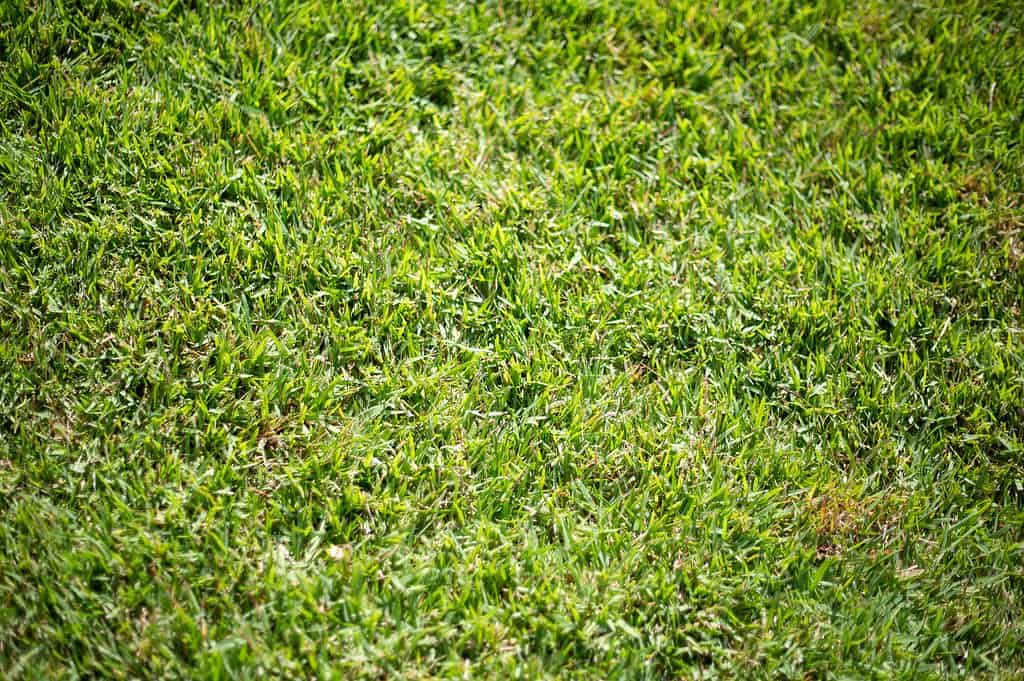
For shade-tolerant lawns, many experts recommend fine-bladed Zoysia cultivars.
©Giulio Giampellegrini/Shutterstock.com
Zoysia grass can tolerate shade to some extent, although it still prefers sunny conditions and cannot be considered a shade-loving grass. However, when it comes to low-light tolerance, Zoysia grass outperforms Bermuda grass, making it a better choice between the two. If you live in subtropical areas like Florida, you can successfully cultivate Zoysia.
For shade-tolerant lawns, many experts recommend fine-bladed Zoysia cultivars. One such exceptional shade-tolerant variety is Zeon, often used on sports fields and golf courses. Geo Zoysia is another fine-bladed grass that thrives in the shade, boasting a deep green turf that can withstand foot traffic and wear.
Patience is essential when establishing a Zoysia lawn, whether you’re using seeds or plugs. It can take up to two years for the plugs to spread and fully cover the lawn. If you opt for seed planting, you may need to wait around three years to achieve complete coverage.
Even though Zoysia is a warm-season turfgrass, it requires a minimum of three to four hours of direct sunlight to thrive. This means it may not be an ideal choice for lawns situated in areas with prolonged, deep shade.
Keep in mind that certain Zoysia cultivars, like emerald Zoysia, may not be ideal for areas with extended periods of shade. These varieties have slow growth rates and can be outcompeted by aggressive weeds like crabgrass.
Zoysia grass is also known for its exceptional drought resistance, which makes it a great choice for areas with water restrictions or infrequent rainfall. Additionally, Zoysia is generally a slow-growing grass, requiring less mowing than other turfgrass varieties. This can be a significant advantage for those who prefer a low-maintenance lawn.
5. Perennial Ryegrass
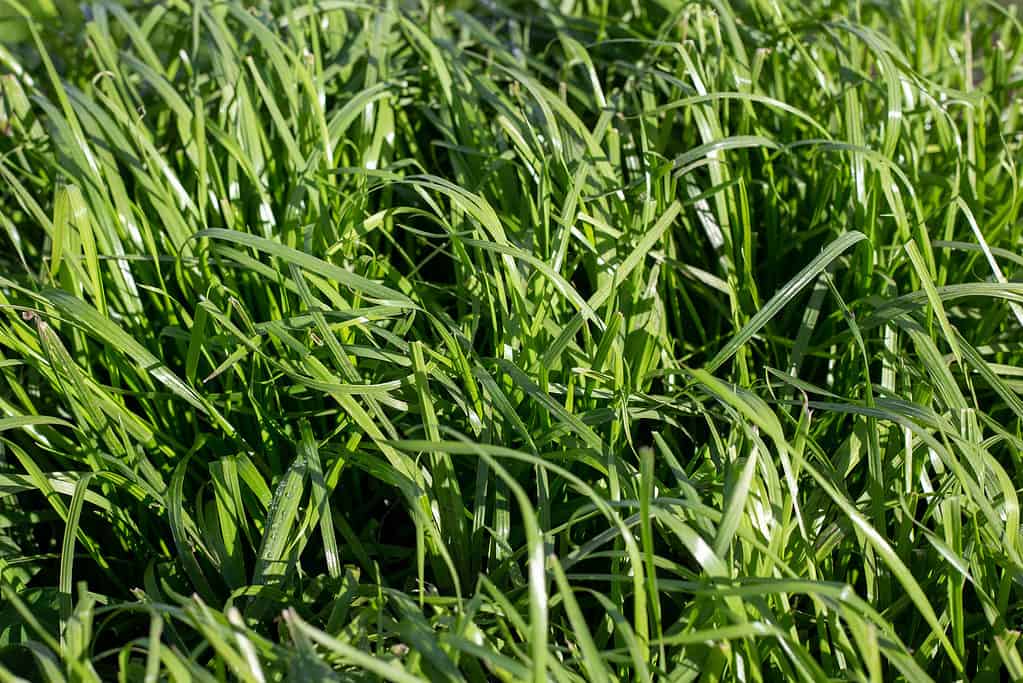
Ryegrass thrives in fertile and well-drained soil, although it can adapt to various types of soil.
©Sheryl Watson/Shutterstock.com
Some varieties of ryegrass do not thrive in shady areas. For areas with low sunlight, perennial ryegrass is highly recommended, as it can tolerate such conditions better than other types of grass.
Perennial ryegrass is a cool-season turfgrass that exhibits a dark, glossy, and vibrant green color. While it can be used on its own, it is often combined with warm-season grasses and other seed blends to complement them.
Keep in mind that perennial ryegrass prefers climates with temperatures ranging between 68°F and 77°F. Its shade tolerance remains even during the summer months if the lawn receives some moisture. However, during hot summer weather with soil temperatures exceeding 90°F, it is not uncommon for ryegrass to suffer and die off.
Perennial ryegrass thrives in fertile and well-drained soil, although it can adapt to various types of soil. It can withstand poorly drained soil and is often utilized in such conditions. The grass exhibits tolerance towards both acidic and alkaline soils, with a pH range of around 5 to 8.3.
You can grow perennial ryegrass through seed, and it tends to germinate relatively quickly. It has excellent traffic tolerance, and during the peak growing periods in May and June, a new leaf is produced approximately every seven to eight days. This necessitates a grazing rotation of about 18-21 days in length.
6. Bluegrass
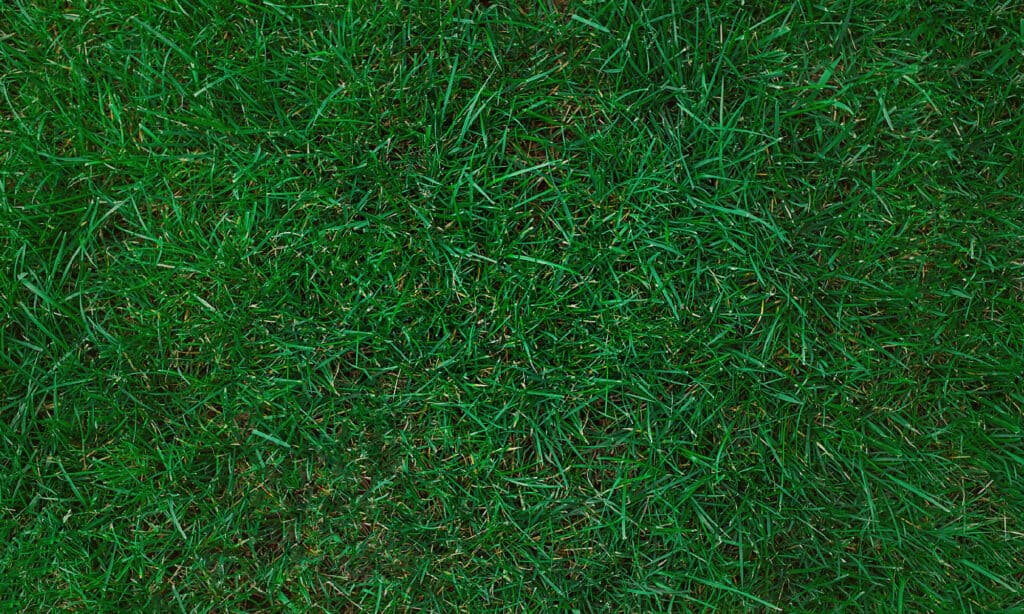
It is remarkable that many bluegrass lawns can thrive for extended periods, even without additional watering.
©iStock.com/KacieBuccieri
Bluegrasses can be slender annual or perennial plants with slender, narrow leaf blades that have blunt or boat-shaped tips. They also possess a membranous ligule, a small appendage at the base of the leaf. The flowers of bluegrasses typically consist of small spikelets that are arranged in open clusters, lacking bristles.
It is remarkable that many bluegrass lawns can thrive for extended periods, even without additional watering. These grasses reside in temperate and tropical climates worldwide and have naturalized in areas beyond their native range. They serve various purposes, such as being useful for lawns and pastures. Additionally, gardeners cultivate some species for their ornamental value.
When it comes to shade tolerance, rough bluegrass stands out among the bluegrass varieties. This particular type of bluegrass thrives in shady, wet, and cool areas. However, if you plan to establish a lawn in hot temperatures, it is advisable to avoid rough bluegrass, as it tends to die off during summer, leaving brown patches in your lawn.
Rough bluegrass, even in shady areas, can be quite aggressive in cool climates with moist soil, particularly under trees. However, it still needs approximately four hours of dappled sunlight each day to truly flourish.
Of course, it is impossible to discuss bluegrass without mentioning Kentucky bluegrass. This variety is highly suitable for cool-season lawns. While Kentucky bluegrass lawns can still grow reasonably well in partial shade, they do require some direct sunlight.
Since bluegrass has a slower growth rate (around 14 days for germination), it takes time for it to establish fully. It is not unusual for the full establishment process to take one to two months. However, once established, bluegrass spreads rapidly through the extensive production of rhizomes.
7. Centipede
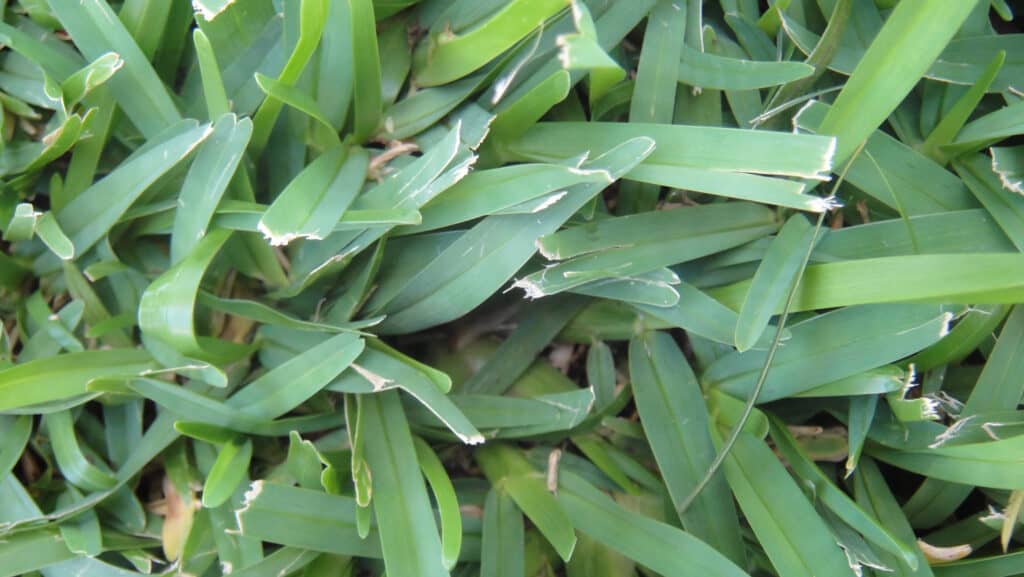
Lovely
centipede
grass can tolerate some shade and flourishes best in the dappled shade found beneath pine trees.
©MarkS26/Shutterstock.com
Centipede grass, classified as a warm-season turf, thrives in moderate climates, making it an excellent choice for ground cover. Its prime growth period occurs during the warm months, from late spring to summer.
The grass blades of the centipede are slender and light green, forming a dense, carpet-like lawn as it creeps along. Typically, the blades measure around 1/8″ to 1/4″ in width, with a height reaching 3 to 4 inches.
Fortunately, centipede grass exhibits adaptability to different conditions. While it thrives in sunlight, it can still grow in partial shade with satisfactory results. However, be aware of foot traffic, as constant activity can negatively impact the grass’s health. Centipede grass can tolerate some shade and flourishes best in the dappled shade found beneath pine trees.
This type of grass requires minimal upkeep and is highly tolerant to heat, making it ideal for regions with acidic, sandy soils prevalent in the Southeastern states, from the Carolinas to the Gulf Coast of Texas. Outside of this geographic area, centipede grass struggles in either excessively cold winters or alkaline soil conditions. Compared to other warm-season grasses, centipede grass demands less mowing and fertilizer.
When establishing a new centipede grass lawn, either seed or sod, depending on available time and budget. Late spring to early summer is the optimal period for initiating the growth of a centipede grass lawn. Since centipede grass relies on warm weather, the soil temperature should be at least 70°F for successful seed germination.
Patience is required. Centipede grass may exhibit slow initial growth, with germination taking anywhere from 10 to 28 days.
Summary of the Top 7 Best Types of Grass That Grow in Shade
| # | Grass | Appearance |
|---|---|---|
| 1 | Fine Fescue | Medium to blue-green finely textured leaves |
| 2 | Velvet Bentgrass | Vibrant green hue and velvety texture |
| 3 | St. Augustine | Varying shades of green from blue-green to dark to emerald |
| 4 | Zoysia | Fine blades of deep green |
| 5 | Perennial Ryegrass | Dark, glossy, vibrant green |
| 6 | Bluegrass | Slender, narrow blue-green leaf blades with blunt or boat-shaped tips |
| 7 | Centipede | Slender, light green blades that are dense and carpet-like |
The photo featured at the top of this post is © Yanti Lin/Shutterstock.com
Thank you for reading! Have some feedback for us? Contact the AZ Animals editorial team.







